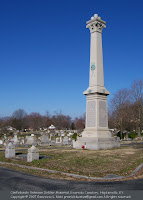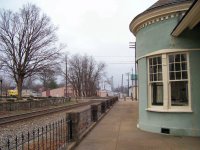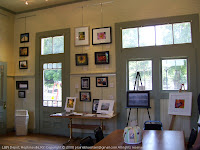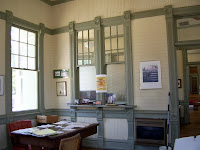History of a Christian County health spa
Like most roads with interesting names, Salubria Springs Road (just west of Pembroke, Kentucky) has a story.
Salubria was once a small settlement in Christian County, located near a natural spring (or springs.) In the early 1800s, one of Christian County's first churches was built at Salubria. William Henry Perrin included Salubria in a list of minor settlements in his 1884 history of Christian County, stressing that all of them were much smaller than Pembroke.
The spa envisioned
The name "Salubria Springs" referred to the healthful (salubrious) effects of the spring water. It had a significant sulfur content. (Mineral water of this flavor isn't valued nearly as much today as it once was!)
In the day of horse-drawn transportation, city dwellers who could afford it spent summers in the country. Cities smelled bad in the heat, partly because of all the horse manure. Hotels at mineral springs were popular vacation spots.
Cerulean Springs (about 15 miles northwest of Hopkinsville) had a successful hotel by the mid-1800s, and
Dawson Springs (about 25 miles north of Hopkinsville) drilled a mineral-water well and entered the health-spa scene around 1900.
Perhaps inspired by the success of Dawson Springs, turn-of-the-century entrepreneur Doug Lander saw potential in the sulfur water of Salubria Springs. He and two other investors from Pembroke purchased the site and implemented an optimistic plan. Wells were drilled to supplement the spring water, and in 1907, the Forbes Manufacturing Company (a well-respected and prolific local builder) was
given the contract to build a large hotel.
The Salubria Springs hotel was a long (170 foot), two-story building. For promenading in the fresh, country air, it had a full-length porch on the ground floor and a full-length balcony on the second floor. There were 40 rooms, including two dining rooms, and an enclosed stairwell at each end. The larger dining room doubled as a ballroom. Two outhouses were located behind the hotel.
The hotel years
Salubria Springs Hotel opened in the summer of 1908. A grid of streets was laid out, and lots around the hotel were offered for sale. But business was slow, and profits did not meet the expectations of the investors. By 1910, the hotel had a new owner and new management.
The
Kentucky New Era described the Salubria Springs opening ball of 1910 in glowing terms:
The big hotel never before entertained such a crowd and never was there a more delightful event given under its hospitable roof. People came from every direction and from long distances. They came in automobiles, horseback, in buggies, wagons, surreys and every kind of vehicle, on the trains and some even walked. Hopkinsville and Pembroke turned out almost en masse, but Fairview, Elkton, Trenton, Guthrie, Clarksville, Madisonville, Princeton, Henderson, Evansville and many other towns sent large delegations. The crowd was even beyond expectations, but they were hospitably cared for by Mr. and Mrs. F. G. Petre, the lessees of the hotel. (Source: "Opening Ball at Salubria," Kentucky New Era, June 24, 1910)
There was no train station at Salubria Springs, but apparently the train stopped somewhere in the area and let off the passengers who wanted to visit the hotel.
By 1912, the hotel had sold to Guy Dority. He produced a brochure that advertised a month's stay at the Salubria (including three meals a day) for just $40. A two week stay cost $24. And, the brochure claimed, a stay at the Salubria improved a body: "The waters have proven to be especially beneficial in diseases of stomach, liver and kidneys. Good for the tired feeling. The run-down go home wound-up and ready for a fresh start. The very best place to rest and build up." (As quoted from the brochure by Joe Dorris in "Watching the Parade,"
Kentucky New Era, April 1, 1989.)
Other uses of the building
1912 seems to have been the last season that the hotel was kept open. A well-to-do lady named Mrs. A. O. Daugherty owned the property later. I do not know if she was connected in any way to the Guy Dority who owned it in 1912, but their names certainly sound similar. Mrs. Daugherty lived at Salubria Springs in the summer and in California in the winter. She employed Mr. Browder Dossett and family as caretakers, and they lived in the hotel year-round. ("Watching the Parade,"
Kentucky New Era, Sept. 24, 1976.)
Dances and other occasional events were held at the ballroom during Mrs Daugherty's years of ownership, and bottled water from the springs was sold by mail-order. I'm not sure when her era at the hotel ended, but an advertisement in the
Kentucky New Era on August 1, 1929 (image at left) hints that an attempt was made that year to put the hotel back into operation.
In 1931, the property was purchased by Christian County. The old poor farm north of Hopkinsville was closed, and Salubria Springs Hotel became the new Christian County Benevolent Home. It was used for this purpose through the late 1950s. The county sold the property at auction in 1958.
The hotel then became the Salubria Springs Home for the Aged. As a nursing home, it had
at least two different owners, before fire safety regulations finally
forced it to close for good in 1970. Ironically, fire destroyed the building in December, 1976. In 1977, the Fiscal Court was petitioned by landowners to formally close eight avenues in the area.
Salubria Springs now
When I drove down Salubria Springs Road last week, I could detect no sign of the hotel. I crossed a bridge over a small creek that may be fed by the springs. I saw several large, modern tobacco barns in a field near the road, and I saw the industrial park nearby. The road circles an overgrown clump of trees, which may be the old hotel site. I didn't see anyone there to ask, so I am only guessing about that.
--------------
See an image of the old hotel building in this 1965
advertisement for the sale of the Salubria Springs nursing home.
A
photograph of Salubria Springs Hotel, taken in 1933, appears in William Turner and Ladonna Dixon Anderson's book,
Cerulean Springs and The Springs of Western Kentucky.

















































